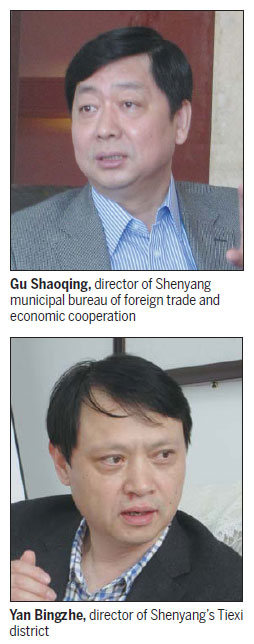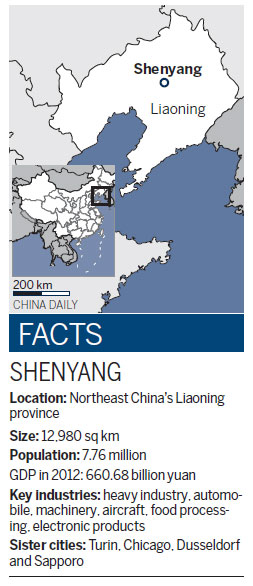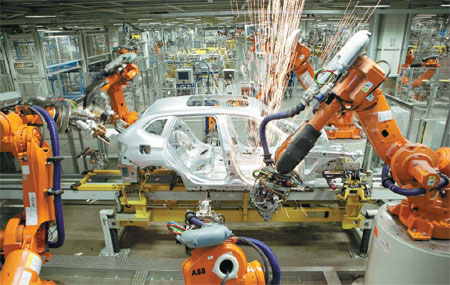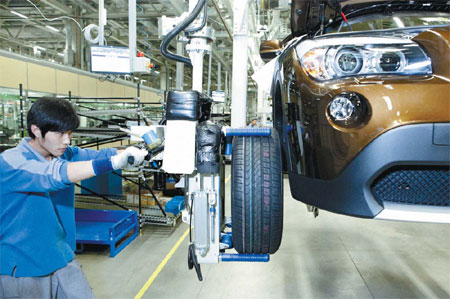Leading lights in Northern revival
Updated: 2013-05-31 08:56
By Zhong Nan and Wu Yong (China Daily)
|
|||||||||||
|
The BMW plant in Shenyang has rejuvenated the city, which 30 years ago was a hub of heavy industries in China. Provided to China Daily |
|
A worker at a BMW assembly line installs tires to the body of a car. Provided to China Daily |

German car maker in pole position to help fallen industrial giant rise again
From being a tattered notch on China's rust belt not so long ago, Shenyang today is polishing itself up to become one of the brightest buttons of the nation's development program.
The capital of the northeastern province of Liaoning was once a titan of heavy industry. At its peak in the 1970s it was among the top three industrial centers with Shanghai and Tianjin, before declining rapidly the following decade, when it found it difficult to adapt to the structural reforms of the new market economy.
The city of 8 million was decimated by factory closures and suffered unemployment as heavy as its main industries - steel and machinery.
Rejuvenation only began to be seen this century when in 2003 the central government launched its "Revitalize Northeast China" campaign. This covered the three northern-most provinces and part of Inner Mongolia, and was largely aimed at taking advantage of the region's strategic position neighboring Russia, Mongolia and the Korean Peninsula.
More importantly, as far as Shenyang was concerned, the city's character and identity, and its old heavy industries, would be revitalized too.
Crucial to the transformation, however, was the need to attract foreign investment. American and German companies in particular had been interested in the city in the 1990s because it aligned with the needs of their own changing heavy industries.
But it was mainly the Germans who lasted the course, and one company in particular saw the mutual benefits to be gained by Shenyang and China's rapid economic and technological development - BMW.
The same year the Chinese government announced its northeast revitalization plan, the German luxury car maker and Brilliance China Automotive Holdings Ltd formed a joint venture.
BMW Brilliance Automotive Ltd (BBA) built a plant in the city's Dadong district to produce BMW 3 and 5 Series models, with production capacity set at 10,000 units per year. In 2004, it sold 8,661. But with sales continuing to grow rapidly, production would rise to 100,000 a year by 2010.
Realizing the huge potential, with increasingly affluent Chinese taking to the roads in droves, BBA that year raised its investment from 560 million euros ($722 million) to 1.5 billion euros to build its second factory in Shenyang's Tiexi district, the old industrial heart where many factories were built during the state's first five-year plan (1951-56). This time, it has added a test center, more manufacturing facilities, warehouses and production lines for the SAV X1.
The Tiexi plant opened in 2012, and is gearing up to produce 200,000 units per year. This year BBA is building a new engine factory nearby with a planned production capacity of 400,000 engines in 2015.
More significantly for Shenyang, BMW's success has revved up many other companies from Europe looking to invest in the city.
There are now 53 German companies operating in Shenyang, 21 of them dealing in automotive parts or in related businesses.
German companies such as Draexlmaier Group, ZF Friedrichshafen AG and Wurth Group have all moved production lines to Shenyang to supply automobile parts to BBA. ZF Lemoore Automotive Systems (Shinnying) Co Ltd operates an independent workshop supplying gearboxes to BBA's Tiexi plant.
German conglomerates such as Siemens, chemical giant BASF and steel heavyweight Heraeus have already built a strong presence in Shenyang, with Siemens electronic components also being largely used in BBA's plants.
"Shenyang used to be one of China's hubs for domestic production 30 years ago, producing a huge amount of machinery," says Gu Shaoqing, director of Shenyang municipal bureau of foreign trade and economic cooperation. "In today's global economic environment, the new government now wants to focus on domestic consumption again, so this is the time for Shenyang to take the opportunity to move on."

Consequently, with this major industrial gear change from reverse to top over that period, and a change as to who is in the driving seat, BMW through BBA recognizes the need to improve its localization strategy.
BBA's Tiexi plant has promoted more than 70 Chinese staff from assistant managers to section managers in the past year, responsible for production, logistics, communication, and training of the 4,000-strong workforce. BBA has a total of 12,500 employees in China.
"Another important step of accelerating localization is that BBA announced a new brand, the Zinoro, which will be the first stage of a new-energy vehicle," says Olaf Kastner, president and CEO of BBA.
Produced at the Tiexi plant, the electric-drive vehicle is scheduled to be unveiled at the Guangzhou Motor Show in November, with a market launch planned for early 2014.
BBA becoming a major player in Shenyang also benefits Chinese companies, of course. Chinese parts suppliers and business partners increased to 320 in 2012, with BBA purchasing 12.5 billion yuan (1.58 billion euros, $2 billion) worth of auto accessories and services from local companies.
Not so much on the back of, as rolling underneath BBA's successs, foreign tire producers, such as Japan's Bridgestone and France's Michelin, also hope to turn China into their biggest market by making more investment in Shenyang. Michelin spent $1.45 billion (1.18 million euros) to build a tire factory last year, and Bridgestone has enlarged its manufacturing facilities.
Huang Taiyan, president of Liaoning University, says building up the automobile and related industries means a lot to Shenyang in transforming its traditional heavy industries into high-tech machinery manufacturing.
The city's service sector will also be improved significantly along with its long-term goal of becoming a top-tier city in China, he says.
"The growth of BMW in Shenyang reflects that more German companies are optimizing their resources to China, which hasn't been severely hit by the global debt crisis," says Yan Bingzhe, director of Shenyang's Tiexi district.
"We are negotiating investment details with four other German companies which want to build an auto parts plant, representative offices and a hotel in Shenyang over the next two years."
Yan says China's other major trade partners South Korea and Japan also benefit from growing German influence in Shenyang because of their close proximity to the region.
"While China, Japan and South Korea increase cooperation to expand investment, facilitate trade flows and reduce trade tariffs among the three neighboring nations, South Korean and Japanese consumers can purchase BMW cars from Shenyang, which could be relatively cheaper than buying the same type of vehicle in their home markets."
Contact the writers at zhongnan@chinadaily.com.cn and wuyong@chinadaily.com.cn
(China Daily European Weekly 05/31/2013 page16)
Today's Top News
List of approved GM food clarified
ID checks for express deliveries in Guangdong
Govt to expand elderly care
University asks freshmen to sign suicide disclaimer
Tibet gears up for new climbing season
Media asked to promote Sino-Indian ties
Shots fired at Washington Navy Yard
Minimum growth rate set at 7%
Hot Topics
Lunar probe , China growth forecasts, Emission rules get tougher, China seen through 'colored lens', International board,
Editor's Picks

|

|

|

|

|

|







